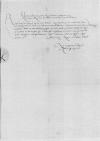Letter #5696
Sigismund I Jagiellon to Ioannes DANTISCUSCracow (Kraków), 1539-05-03
| received [1539]-05-25 Manuscript sources:
| ||||||
Text & apparatus & commentaryPlain textText & commentaryText & apparatus
Reverendo in Christo Patri, domino
Reverende in Christo Pater, sincere nobis dilecte.
Quas petit Paternitas Tua a nobis dari litteras ad sanctissimum dominum nostrum, eas libenter sumus daturi. Ceterum de reiciendis in aliud tempus
Datum
Ad mandatum regiae maiestatis proprium

